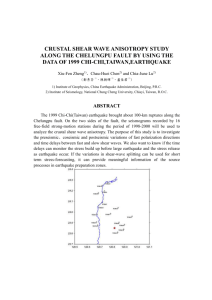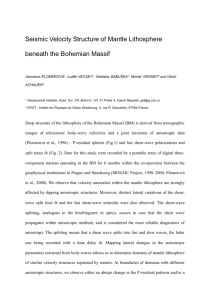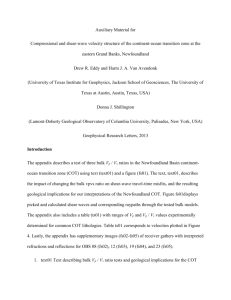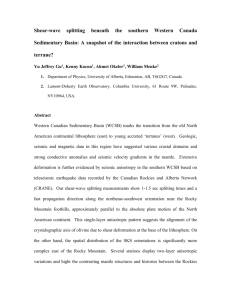spsc04 - School of GeoSciences
advertisement
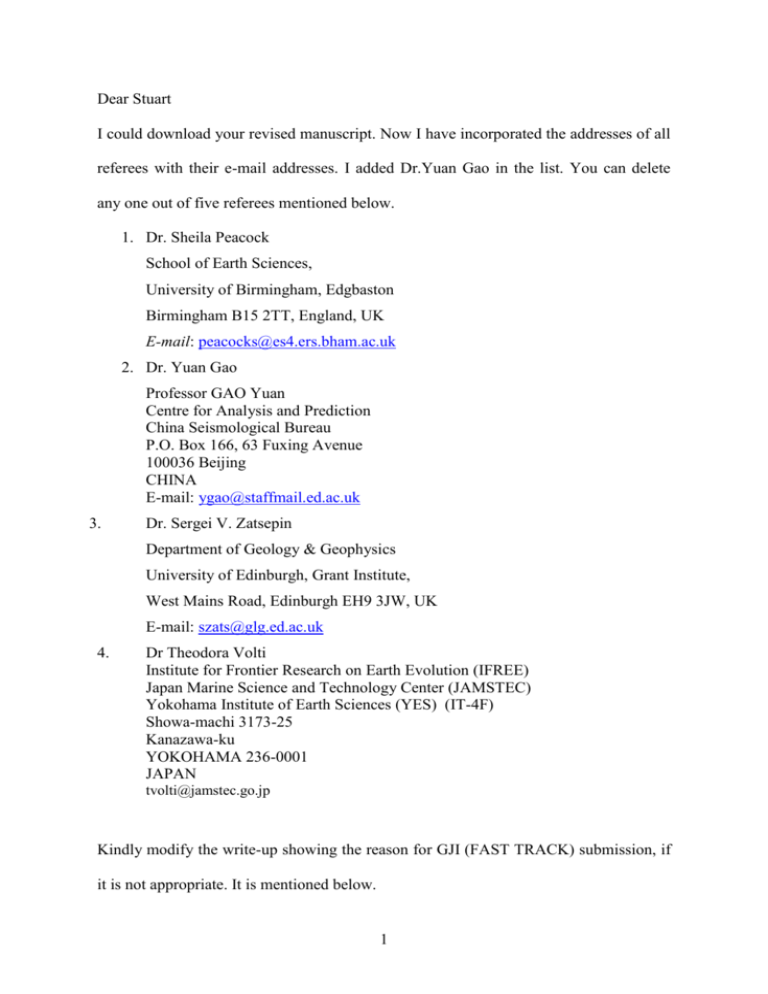
Dear Stuart I could download your revised manuscript. Now I have incorporated the addresses of all referees with their e-mail addresses. I added Dr.Yuan Gao in the list. You can delete any one out of five referees mentioned below. 1. Dr. Sheila Peacock School of Earth Sciences, University of Birmingham, Edgbaston Birmingham B15 2TT, England, UK E-mail: peacocks@es4.ers.bham.ac.uk 2. Dr. Yuan Gao Professor GAO Yuan Centre for Analysis and Prediction China Seismological Bureau P.O. Box 166, 63 Fuxing Avenue 100036 Beijing CHINA E-mail: ygao@staffmail.ed.ac.uk 3. Dr. Sergei V. Zatsepin Department of Geology & Geophysics University of Edinburgh, Grant Institute, West Mains Road, Edinburgh EH9 3JW, UK E-mail: szats@glg.ed.ac.uk 4. Dr Theodora Volti Institute for Frontier Research on Earth Evolution (IFREE) Japan Marine Science and Technology Center (JAMSTEC) Yokohama Institute of Earth Sciences (YES) (IT-4F) Showa-machi 3173-25 Kanazawa-ku YOKOHAMA 236-0001 JAPAN tvolti@jamstec.go.jp Kindly modify the write-up showing the reason for GJI (FAST TRACK) submission, if it is not appropriate. It is mentioned below. 1 “This is for the first time that a study on shear-wave splitting has been carried out in India for 2001 Bhuj earthquake aftershock zone. It gave some interesting results of the presence of fluids at the fault zone from 90–flip in fast polarisation directions consistent with APE modelling”. After your acknowledgement, I will send online. With thanks and best regards, Simanchal Padhy 2 Evidence of high pore-fluid pressures inferred from 90–flips in shear–wave polarisations at Bhuj Simanchal Padhy1 & Stuart Crampin2 1 Seismological Observatory, National Geophysical Research Institute, Hyderabad-500007, INDIA; sp_ngri@yahoo.com. 2 School of GeoSciences, University of Edinbvurgh, Grant Institute, West Mains Road, Edinburgh EH9 3JW, SCOTLAND UK; also at Edinburgh Anisotropy Project, British Geological Survey, Murchison House, West Mains Road, Edinburgh EH9 3LA, SCOTLAND UK; scrampin@ed.ac.uk SUMMARY Shear-wave splitting above local earthquakes in the aftershock zone of the 2001, Mw 7.6, Bhuj earthquake display a spatial variation of anisotropy related to the crack orientation. With one exception, the fast polarisation directions, , are approximately NNE-SSW, parallel to the direction of maximum horizontal stress, suggesting the dilatancy-induced anisotropy resulting from parallel vertical cracks. In contrast, the fast polarisation direction, , at Station Samkhyali (SKL), very close to the epicentre of the main shock, are fault-parallel, approximately E-W, and almost orthogonal to the stressaligned polarisations elsewhere. APE modelling suggests that these 90–flips in shearwave polarisations, caused by propagation through cracks containing fluids at high pore-fluid pressures surrounding the seismically-active fault plane. The presence of high pore-fluid pressures on seismically active faults also explains the large scatter in shear-wave time delays. The average delay time, t, varies from 48 ms to 102 ms, except at Station SKL, where a larger delays of up to 430 ms are found. This could be explained by 15% velocity anisotropy, among the highest reported for local earthquakes, and a large crack density greater than = 0.1. The time delays, t, exhibit a large scatter, showing no correlation with distance or depth. It suggests that the splitting occurs near the source region of the Bhuj earthquake. These observations can be explained by the presence of both conventional stress-aligned shear-wave polarisations and 90–flips at Bhuj. 3 Key words: Anisotropy, APE, Bhuj earthquake, EDA, shear-wave splitting. 1 Introduction The existence of seismic velocity anisotropy can be recognised by shear-wave splitting (Crampin et al. 1981; Crampin 1994), where the polarisation of the leading split shearwave, , and the time delay, t, between two orthogonally polarised pulses. Studies of shear-wave splitting in the crust in many places around the world (Crampin et al. 1981; Crampin 1994) have been interpreted as stress-aligned fluid-filled microcracks or fractures resulting in dilatancy-induced anisotropy. Various other potential sources of stress-aligned anisotropy can be essentially eliminated (Crampin 1994). The Gujarat province in Western India suffered the catastrophic 2001, Mw 7.6, Bhuj earthquake. The main shock occurred in the Kutch Rift Basin (KRB), which is underlain by a Mesozoic rift system in the western margin of the peninsular India craton. The area has witnessed several historical large earthquakes in the past. This abundant seismicity suggests that significant levels of stress must be prevalent throughout the fault zone. Shear-wave splitting tool is a useful tool for investigating spatial variations of stress. For the first time in this area, we address the crustal heterogeneity and the conditions of stress in the crust, both intimately related to the occurrence of earthquakes. Shear-waves from the Bhuj aftershocks show the evidence of both conventional stress-aligned and 90–flips in shear-wave polarisations (Crampin et al. 2002). 2 Data and Methods The data used are aftershocks (ML 2.5 to 3.5) with clean, impulsive shear-wave arrivals within the 35 (sin-1 VS/VP for a Poisson’s ratio of 0.25) shear-wave window, so that the shear-waves are not disturbed by S-to-P conversions (Booth & Crampin 1985). The events are recorded by a National Geophysical Research Institute (NGRI) local network of four stations (CHP, CHB, RPR, and SKL) in Fig. 1 in the aftershock region of Bhuj earthquake. All stations have three-component seismometers, recorded at a sampling rate of 100 Hz. The depths of the selected events range from 10-35 km. The earthquakes are located using HYPO71 (Lee & Lahr 1975) with the velocity model 4 (Table 1) used for the region (B. K. Rastogi, personal communication). All the events are located by more than six stations with an average RMS < 0.1s, and hypocentre locations are accurate to 1-2 km. The small magnitude earthquakes have frequencies greater than 10 Hz and the displacement seismograms are low-pass filtered (<10 Hz) to remove micro-seismic noise. All earthquakes have small magnitudes (ML 2.5 to 3.5), and the bulk of the energy is in this frequency range. The horizontal components are rotated into the radial (earthquake-to-station azimuth) and transverse directions. A particle motion plot shown in Fig. 2b of the horizontal components is used for shear-wave splitting analysis. Fig. 2b shows clear first motion direction (S1) upon first shear-wave arrival, followed by a change in direction several milliseconds later upon the slow arrival (S2). The crosscorrelation method is used for the analyses (Shih & Meyer 1990). The two horizontal component seismograms are rotated clockwise from North (0) to East (90) in steps of 5. The cross-correlation coefficient between the two rotated waveforms in the time window are computed for lags between +0.5 s and –0.5 s with an increment of 0.01 s. When the absolute value of the cross-correlation coefficient reaches a maximum, that rotation is regarded as the fast polarisation direction, , and the lag is estimated as the delay between the fast and slow split shear-waves, t. Events with cross-correlation coefficients greater than 0.85 are used to avoid noisy and complicated seismograms. Fast polarisation directions and delay times could be measured for most events with uncertainties less than 10 and 30 ms, respectively. 3 Results and Discussion Clear shear-wave splitting with consistent leading shear-wave polarisations and identifiable fast and slow shear-wave arrivals are good evidence that the observed polarisation alignments are caused by seismic anisotropy. The shear-wave splitting of the Bhuj aftershocks show a spatial variation of anisotropy related to the crack orientation. The fast polarisation directions, , are approximately NNE-SSW (N35E for Station RPR as shown in Fig. 2-f), subparallel to the direction of maximum horizontal stress, suggesting the dilatancy induced anisotropy resulting from parallel stress-aligned vertical cracks. In contrast, the fast directions, 5 at Station SKL are fault-parallel and, are approximately E-W, and generally orthogonal to the stress-aligned polarisations elsewhere indicating 90–flips in shear-wave polarisations (Crampin et al. 2002). Previously, it has been suggested that fault parallel polarisations indicates new fractures parallel to fault strikes are produced by the shear faulting of the main shock. As has been observed by Tadokoro et al. (1999) and Zhang & Schwartz (1994) along the fault zone of 1995 Kobe and 1989 Loma Prieta earthquake, respectively. A new understanding of rock mass deformation, the anisotropic poro-elasticity (APE) model (Zatsepin & Crampin 1997; Crampin & Zatsepin 1997), suggests that such 90–flips in shear-wave polarisations are caused by propagation through cracks or micro-fractures containing fluids at high pore-fluid pressures surrounding the seismically-active fault zone (Crampin et al. 2002). The high pore-fluid pressures reorganise the microcrack geometry so that for nearly vertical propagation the shearwave polarisations are perpendicular to the prevailing direction of maximum horizontal stress leading to 90–flips in shear-wave polarisations (Crampin et al. 2002). Such 90– flips in polarisation directions have been observed above small earthquakes previous studies (Liu et al. 1997; Miller & Savage 2001; Peacock et al. 1988; Crampin et al. 2004). The existence of high pore-fluid pressures is supported by tomographic evidence of presence of fluids near the hypocentre characterised by high Poisson’s ratio (Kayal et al. 2002; Mishra & Zhao 2003). 90– flips in the high pressures near a source on a small fault will revert to stress-parallel polarisations as the wave leaves the highpressure zone and propagates through the lower pressures away from the fault. This means that the shear-wave splitting observed at the surface is a combination of both 90–flips and conventional stress-aligned polarisations in proportion to the ratio of highto low-pressure segments of the ray path (Crampin et al. 2004). Since every small earthquake modifies the stress field and modifies the distribution of high pore fluidpressures, the scatter in shear-wave splitting time delays is expected because of the varying proportions of high- to low- pressure path segments (Crampin et al. 2004). This explains the large scatter observed in time delays versus distance or depth plots (Fig. 3) from similar earthquakes with similar ray paths, which is too large to be explained by conventional geophysical sources of scatter (Volti & Crampin 2003). 6 The average delay time, t, at all stations varies from 48 ms to 102 ms, except at Station SKL, where the large delay of up to 430 ms is found. This could be explained by 15% velocity anisotropy, among the highest reported for local earthquakes, and with a high fracture density of more than = 0.1. This is presumably associated with higher crack densities in the immediate vicinity of the vertical fault. The higher crack densities may be related to a higher stress field in Bhuj. The time delays in Fig. 3 show no correlation with hypocentral distance or focal depth. It could be that the scatter is so large that correlations with depth are difficult to see. However, it does suggest that significant splitting occurs particularly in lower crust from 15-30 km, where the majority of earthquakes occurred. The most typical distribution is maximum ~5% in upper half crust and ~10+% in lower half crust. This is consistent with the evidence that the lower crust has particularly large percentages of shear wave velocity anisotropy (Graham & Crampin 1993). The large scatter of lags is probably associated with the 90–flips on all seismically-active fault planes (Crampin et al. 2004). A large observed time-delay of up to 430 ms at SKL yields estimates of 15% anisotropy, among the highest reported for local earthquakes, except for the high values reported in Iceland (Volti & Crampin 2003), where it is believed to be associated with the high heat flow in Iceland. A large degree of anisotropy means a large crack density, ( = N a3/v, where N is the number of thin circular cracks with a radius of a in volume v) of up to = 0.2, as observed by Mishra & Zhao (2003). It can also be estimated from the observed delays using the velocities of fast and slow split shear-waves in Hudson (1981) and assuming that the ray paths propagate vertically in an anisotropic medium as = |t| VS / l, where l is the length of a ray path in anisotropic medium. Even the stations that show stress aligned polarisation exhibit a significant scatter about the mean directions (Fig. 4). Such scatter of directions is characteristic of shear-wave splitting above small earthquakes (Crampin & Booth 1985; Crampin 1994). 4. Conclusions Analysis of shear-wave splitting to the 2001 Bhuj aftershocks detect both stress induced and fault parallel anisotropy broadly consistent with observations above small 7 earthquakes elsewhere. The fast polarisations are in general sub-parallel to the direction of regional compressive stress. However, station SKL exhibit fault-parallel polarisations (90–flips) and exceptionally high levels of time delays. These 90–flips are probably associated with high pore-fluid pressures in the seismically-active fault zone persisting to near enough to the surface to be observed. These analyses are consistent with the predictions of APE modelling. The large time delay could be explained by 15% velocity anisotropy in the immediate vicinity of the fault zone. Acknowledgements Professor Masataka Ando is thanked for his critical comments on the paper. We also thanks Dr. Harsh K. Gupta for his thoughtful reading and corrections and Dr. V P Dimri, Director, National Geophysical Research Institute, for his kind permission to publish. REFERENCES Booth, D. C. & Crampin, S., 1985. Shear-wave polarizations on a curved wavefront at an isotropic free-surface, Geophys. J. R. Astron. Soc., 83, 31-45. Crampin, S., Evans, R., Doyle, M. & Davis, J. P., 1981. Comments on papers about shear-wave splitting in dilatancy-induced anisotropy by I. N. Gupta & by A. Ryall & W. U. Savage, Bull. Seism. Soc. Am., 71, 375-377. Crampin, S. & Booth, D. C., 1985. Shear-wave polarizations near the North Anatolian Fault - II. Interpretation in terms of crack-induced anisotropy, Geophys. J. R. Astron. Soc., 83, 75-92. Crampin, S., 1994. The fracture criticality of crustal rocks, Geophys. J. Int., 118, 428438. Crampin, S., 1984. An introduction to wave propagation in anisotropic media, Geophys. J. R. astr. Soc., 76, 17-28. Crampin, S. & Zatsepin, S. V., 1997. Modelling the compliance of crustal rock: II response to temporal changes before earthquakes, Geophys. J. Int., 129, 495-506. 8 Crampin, S., Volti, T., Chastin, S., Gudmundsson, A. & Stefansson, R., 2002. Indication of high pore-fluid pressures in a seismically-active fault zone, Geophysical J. Int., 151, F1-F5. Crampin, S., Peacock, S., Gao, Y. & Chastin, S., 2004. The scatter of time-delays in shear-wave splitting above small earthquakes, Geophys. J. Int., 156, 39-44. Graham, G. & Crampin, S., 1993. Shear-wave splitting from regional earthquakes in Turkey, Can. J. Expl. Geophys., 29, 371-379. Gupta, H. K., Rao, N. P., Rastogi, B. K. & Dipankar Sarkar, 2001. The Deadliest Intraplate Earthquake, Science, 291, 2101-2102. Hudson, J. A., 1981. Wave speeds and attenuation of elastic waves in material containing cracks, Geophys. J. R. Astron. Soc., 64, 133-150. Kayal, J. R., D. Zhao, O. P. Mishra, R. De. & Singh, O. P., 2002. The 2001 Bhuj earthquake: Tomographic evidence for fluids at the hypocenter and its implications for rupture nucleation, Geophys. Res. Lett., 29, 5.1-5.4. Lee, W. H. K. & Lahr, J. C., 1975. HYPO71: A computer program used for determining hypocenter, magnitude, and first-motion pattern of local earthquakes, U. S. Geol. Surv. Open File Rep., 75-S11. Liu,Y., Crampin, S. & Main, I., 1997. Shear wave anisotropy: spatial and temporal variations in time delays at Parkfield, Central California, Geophys. J. Int., 130, 771785. Miller, V. & Savage, M., 2001. Changes in seismic anisotropy after volcanic eruptions: evidence from Mount Ruapehu, Science, 293, 2231-2235. Mishra, O. P. & Zhao, D., 2003. Crack density, saturation rate and porosity at the 2001 Bhuj, India, earthquake hypocenter: a fluid-driven earthquake?, Earth Planet Science Letters, 212, 393-405. Peacock, S., Crampin, S., Booth, D. C. & Fletcher, J. B., 1988. Shear-wave splitting in the Anza seismic gap, Southern California: temporal variations as possible precursors, J. Geophys. Res., 93, 3339-3356. Shih, X. R. & R. P. Meyer, 1990. Observation of shear wave splitting from natural events: South moat of Long Valley caldera, California, June 29 to August 12, 1982, J. Geophys. Res., 95, 11,179-11,195. 9 Tadokoro, K., Ando, M. & Umeda, Y., 1999. S-wave splitting in the aftershock region of the 1995 Hyogo-ken Nanbu earthquake, J. Geophys. Res., 104, 981-992. Volti, T. & Crampin, S., 2003. A four-year study of shear-wave splitting in Iceland: 1. Background and preliminary analysis, in New insights into structural interpretation and modeling, ed. Nieuwland, D. A., Geol. Soc. Lond., Spec. Publ., 212, 117-133. Zatsepin, S. V. & Crampin, S., 1997. modeling the compliance of crustal rock: I response of shear-wave splitting to differential stress, Geophys. J. Int., 130, 771785. Zhang, Z. & Schwartz, S. Y., 1994. Seismic anisotropy in the shallow crust of the Loma Prieta segment of the San Andreas fault system, J. Geophys. Res., 99, 96519661. 10 Table 1: Velocity model used in this study for determination of hypo-central parameters. Depth to top of layer (km) Vp (km/s) Vs (km/s) 0.0 2.3 1.33 0.2 4.99 2.88 0.3 3.4 1.96 2.9 4.7 2.72 3 5.76 3.33 6 6.21 3.59 20.5 7.01 4.05 30 6.66 3.85 37 8.47 4.90 11 FIGURE LEGENDS Fig. 1 Map of the 2001 Bhuj earthquake. mainshock. Star represents the epicenter of the Squares are the locations of the seismic stations: Chobaria (CHB), Chopadwa (CHP), Rapar (RPR), and Samkhyali (SKL). The tectonic features are: ABF: Allah Bund Fault; IBF: Island Belt Fault; KF: Katrol Fault; KMF: Kutch Mainland Fault. The focal mechanism of the main shock is shown to the right of the figure. The average fast polarisation direction at every station are shown by blue straight lines with length proportional to the delay time, t (see scale bar below) (modified from Gupta et al. 2001). Fig. 2 (a) An example of horizontal component seismograms with shear-wave splitting recorded at station SKL; (b) particle motion plot for the horizontal component of shearwaves shown in Fig. 2a. The fast shear-wave (S1) polarisation is ~100 and changes abruptly at the arrival time of the lagging shear-wave (S2); (c) Horizontal component seismograms that have been rotated to the leading/lagging co-ordinate system defined by the computed (N100E) and shifted by the computed t (430 ms), and (d) the corresponding “corrected” particle motion, which is observed as linear. Figs. 2 (e-h) show the above analysis for an event recorded at Station RPR, where the fast polarisation direction is N35E, and the delay time, t, is 80 ms. Fig. 3 Delay times as a function of (a) hypocentral distance, and (b) earthquake depth for located events within a shear-wave window of 35 (straight-line path). The lack of correlation between these parameters suggests that the splitting occurred near the source region of the Bhuj earthquake. Fig. 4 Equal-area rose diagrams of the polarisations of faster split shear-wave arrivals from the local events recorded at the shear-wave windows of CHB, CHP, RPR, and SKL. The Stations CHB, CHP, and RPR show NE-SW polarisation directions that are parallel to the maximum compressive stress direction. At Station SKL, it is found to be fault-parallel (E-W), orthogonal to the maximum stress direction (90–flips in polarisation direction). 12 Fig. 1 13 Fig. 2(a-h) 14 Fig. 3(a-b) Fig. 4 15 16
